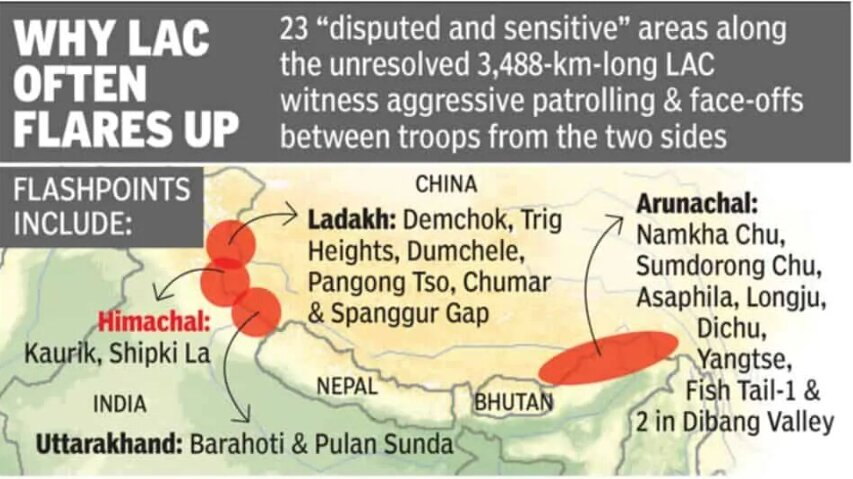International Relations
Diplomacy And Strong Counter-measures
- 10 Aug 2021
- 6 min read
This article is based on To take on China, rely on diplomacy and strong counter-measures which was published in the Hindustan Times on 10/08/2021. It talks about the need for diplomacy as well as strong counter measures in resolving crises across the LAC.
The agreement for mutual disengagement of troops by China and India at the friction point of Gogra in eastern Ladakh is a step forward for restoring the status quo ante of April 2020 (Galwan Clash), when Chinese forces made a series of preplanned intrusions across the Line of Actual Control (LAC).
Including Gogra, Galwan and Pangong Tso, the two sides have now stepped back at three contested points, while the standoff continues at other strategic locations and warrants speedily resolution. There are lessons to be learnt from the three areas where China and India have disengaged.
Negotiations: Lesson Learnt
- Sustained Diplomacy Yields Dividends: Due to several rounds of talks, the two Asian giants have avoided an intensified conflict that seemed a possibility after the Galwan clash.
- The interaction of two militaries at LAC have conveyed in direct terms what each side wants and prefers.
- Moreover, the involvement of the US in favour of India vis-à-vis China also helped lower the heat.
- Diplomatic Parleys are Necessary But Not Sufficient: Without a demonstration of military deterrence and resolve, an aggressive and expansive China cannot be sweet-talked into dismantling its bunkers and semi-permanent structures or driving back its tanks and armoured vehicles to pre-April 2020 positions.
- China has withdrawn from three encroached portions only after witnessing India’s willingness to use countervailing force, do mirror deployment or outnumber the Chinese military at some points, and mount counter-offensives across what China claims to be its side of LAC.
- Offensive Defence: The concept of “offensive defence” has guided India’s strategic infrastructure-building and force projection at LAC throughout the crisis, and this has compelled China to recalculate the costs and benefits of its expansionism.
- Peace Through Strength: Since diplomatic resolution of the crisis is dependent on military operations and shows strategic determination, India must persist on the path of peace through strength.
- This may include activating and operationalising Quad to apply multilateral counterbalancing pressure in the Indo-Pacific; imposing greater barriers to Chinese goods, technology and investments; and reopening the sensitive issues of the status of Tibet and Taiwan.
Challenges
- Suspicious of Each Other’s Intentions: While India and China have long-term suspicions of each other’s intentions, goals and international alignments, the LAC crisis deepens.
- With approximately 50,000 troops on each side remaining at LAC, the potential for fresh violence cannot be ruled out.
- Contest For Power: The two neighbours will not stop competing for power and influence in Asia and beyond, but they can manage the disputed border situation from sliding into war.
- Deepening India-US relations: A difficult path lies ahead in India-China relations, especially as the India-United States (US) strategic partnership is maturing and US-China ties are plumbing the depths.
- Challenges of Military Proactiveness: While Indian military proactiveness is an imperative to deal with the crisis, this kind of equilibrium is unstable and risks unwarranted escalation.
Way Forward
- Keep Up the consultation Momentum: It is imperative for the two sides to cherish the hard-won relaxation, and work together to consolidate the progress, keep up the consultation momentum, further ease the situation, and improve the border management and control mechanisms.
- Both nations need to master the four keys of:
- Leading: It means to reach consensus and guide the direction of the development of bilateral relations under the guidance of leaders from both nations.
- Transmitting: It means to transmit the leaders’ consensus to all levels and translate it into tangible cooperation and outcomes.
- Shaping: It means to go beyond the mode of managing differences, shape bilateral relations actively and accumulate positive momentum.
- Integrating: It means to strengthen exchanges and cooperation, promote convergence of interests and achieve common development.
- Mutual Development: As two big emerging economies, China and India need to pursue development alongside each other, move forward in partnership instead of hindrance, and work together for shared progress rather than erecting walls against each other.
Conclusion
India does not have the option of shying away from Chinese policy toward it. Only a combination of bravery and wisdom can succeed in this long-drawn-out crisis.
|
Drishti Mains Question Without a demonstration of military deterrence and resolve, an aggressive and expansive China cannot be persuaded into dismantling its bunkers and semi-permanent structures across LAC. Discuss. |






-min.jpg)